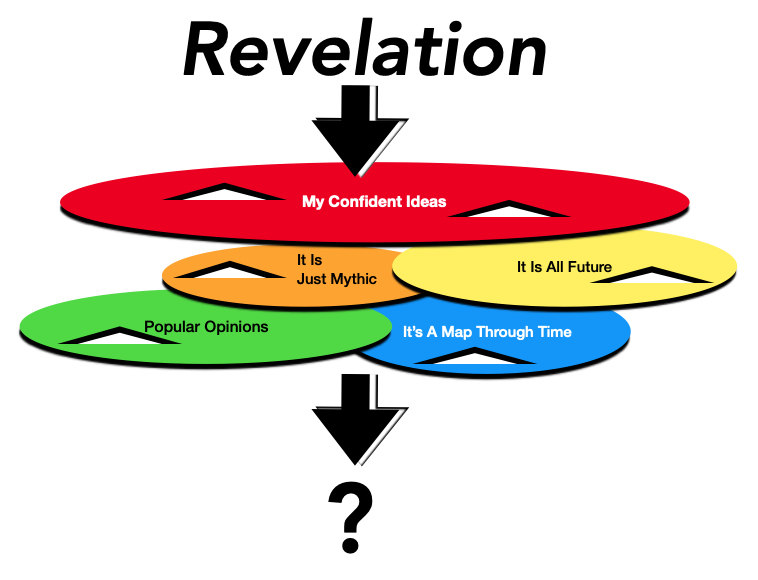What would happen if we would allow Revelation’s literary genre as well as both the immediate and greater contexts of its texts to guide our understanding of John’s Revelation? What would we learn? Picking up from last week’s suggestions, here are some more principles for creating a literary sensitive framework for understanding this book.
5) Revelation Reveals The Identity Of The Dragon.
The dragon is Satan. Rev. 12:9; 20:2 The dragon tries to devour a pregnant woman’s male child who will rule the nations with an iron scepter. Rev. 12:4,5 The dragon pursues the child who is snatched up to God. A war ensues in heaven resulting in the dragon being defeated and cast down to the earth where he then pursues the woman. Since she is protected, he turns against her offspring. Rev. 12:17 Here is a portrayal of Satan’s failed attempts to destroy the Messiah and God’s plan, thus leading the dragon to turn his wrath against Jesus’ disciples.
6) Revelation Identifies The Two Beasts.
The sea beast is similar to the dragon (compare Rev. 12:3 with Rev. 13:1) and is empowered by the dragon to rule. Revelation 13:2. It is a composite of the four beasts from Daniel 7 which were all representatives of political powers. Daniel 7:17 Thus John is describing a political power. This beast from the sea persecutes Christians and rules over other nations. Rev. 13:7
In Revelation 17:9-12 its seven heads are described as representing seven kings and also seven hills. With Rome being built on seven hills, first-century Christians would have identified this political power as the Roman empire that ruled over other nations and persecuted Christians.
The land beast described in Revelation 13:11-17 speaks like a dragon, exercised all the authority of the sea beast on the sea beast’s behalf and made the earth worship the sea beast. For those refusing to worship the sea beast he has the power to kill them.
If the sea beast is the civil authority of Rome, then the land beast promotes emperor worship. Emperor worship was especially strong in the Empire during the reign of Domitian (81-96 A.D.) and affected Asia Minor where the seven churches were located. The two beasts rise together and fall together, so the land beast is not some religious power coming years after the sea beast.
7) Revelation Identifies The Harlot and Babylon.
Both are great cities. Rev. 17:18; 18:10 Both commit fornication with kings. Rev. 17:2; 18:3 Both are adorned with luxury. Rev. 17:4; 18:16 Both have shed the blood of the saints. Rev. 17:6; 18:24 As Revelation 17:5 reveals, both of these symbols are representative of the same great city. Since the harlot rides on the beast, which has already been seen to be the Roman Empire, this great city which rules over the kings of the earth and which rides on the Roman Empire must refer to the glory of Rome. Rev. 17:18
8) Revelation Reveals That The Kingdom Serving God Already Exists.
Since John and other disciples are already in the kingdom, this book is not describing the establishment of God’s kingdom in the future. Rev. 1:6,9
In agreement with the teachings in the New Testament, Revelation 12:10 proclaims that after the male child who will rule the nations with an iron scepter is taken to heaven (i.e. Christ’s resurrection), “now comes the salvation and the power and the kingdom of our God, and the authority of Christ.” Not only did Christ have all authority after his resurrection (Mt. 29:18), and salvation had come, etc. but also, the kingdom began. Thus those writing after Jesus’ resurrection wrote from the perspective of being in the kingdom, not announcing the arrival of the kingdom (Rev. 1:6; Col. 1:12).
Summary Thoughts
If we respect the book’s own claims, the natural methods for interpreting apocalyptic style works, the known symbols and language from the Old Testament and what John reveals about his message, a very brief overview of Revelation’s message would suggest the following. Here is a prophecy revealed by Christ to some beleaguered Christians. After a brief message to each congregation that the Lord knows their specific congregational situation and encourages them to overcome, the reader is ushered into beholding the throne room of God. God is in control. The risen Lord is the only one found worthy to reveal God’s message. Partial judgments by God are announced. A cry is raised by the martyrs, “how long” will it be until the persecutor is judged? Rev. 5:9-10
Although some had already died for Christ, tribulation would continue a little longer. Rev. 5:11 God’s people are encouraged that they would soon experience relief, as Christ would come to judge the persecuting forces of evil empowered by the devil. Those disciples who would remain faithful to the point of death would be victorious and would receive the crown of life. Repeated scenes capture every facet of God’s coming judgment upon the power that had slain God’s people. God’s judgment against those who have killed the ones belonging to the Lamb is shown to be just. There is great reward for those who are faithful.
- God’s answer for modern living - 2025-07-09
- Secure Living - 2025-06-25
- Untimely confidence - 2025-06-18
